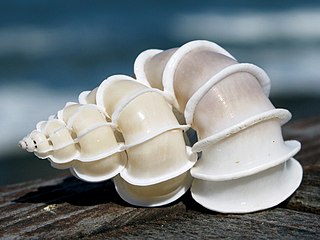
Marine biology is the scientific study of the biology of marine life, organisms in the sea. Given that in biology many phyla, families and genera have some species that live in the sea and others that live on land, marine biology classifies species based on the environment rather than on taxonomy.

The Great Barrier Reef is the world's largest coral reef system, composed of over 2,900 individual reefs and 900 islands stretching for over 2,300 kilometres (1,400 mi) over an area of approximately 344,400 square kilometres (133,000 sq mi). The reef is located in the Coral Sea, off the coast of Queensland, Australia, separated from the coast by a channel 160 kilometres (100 mi) wide in places and over 61 metres (200 ft) deep. The Great Barrier Reef can be seen from outer space and is the world's biggest single structure made by living organisms. This reef structure is composed of and built by billions of tiny organisms, known as coral polyps. It supports a wide diversity of life and was selected as a World Heritage Site in 1981. CNN labelled it one of the Seven Natural Wonders of the World in 1997. Australian World Heritage places included it in its list in 2007. The Queensland National Trust named it a state icon of Queensland in 2006.

Gastropods, commonly known as slugs and snails, belong to a large taxonomic class of invertebrates within the phylum Mollusca called Gastropoda.

Isopoda is an order of crustacean, which includes woodlice and their relatives. Members of this group are called Isopods and include both terrestrial and aquatic species. All have rigid, segmented exoskeletons, two pairs of antennae, seven pairs of jointed limbs on the thorax, and five pairs of branching appendages on the abdomen that are used in respiration. Females brood their young in a pouch under their thorax.

Turritella is a genus of medium-sized sea snails with an operculum, marine gastropod mollusks in the family Turritellidae.

Wentletraps are small, often white, very high-spired, predatory or ectoparasitic sea snails, marine gastropod mollusks in the family Epitoniidae.

Cirsostrema is a genus of very small deepwater sea snails, marine gastropod mollusks in the family Epitoniidae, commonly known as the wentletraps.

Acirsa is a genus of predatory sea snails, marine prosobranch gastropod mollusks in the family Epitoniidae. They are commonly known as wentletraps.
Acirsa subcarinata is a species of minute deep water sea snail or micromollusk. It is a wentletrap in the family Epitoniidae, a marine gastropod mollusk.
The World Register of Marine Species (WoRMS) is a taxonomic database that aims to provide an authoritative and comprehensive list of names of marine organisms.

Robert C. Murdoch was a malacologist in New Zealand.
Acirsa morsei is a species of sea snail, a marine gastropod mollusk in the family Epitoniidae.

Opalia is a genus of small sea snails, marine gastropod mollusks in the family Epitoniidae, commonly known as wentletraps.

A shrimp is a crustacean with an elongated body and a primarily swimming mode of locomotion – typically belonging to the Caridea or Dendrobranchiata of the decapod order, although some crustaceans outside of this order are also referred to as "shrimp".

Heteropsammia is a genus of apozooxanthellate corals that belong to the family Dendrophylliidae.











